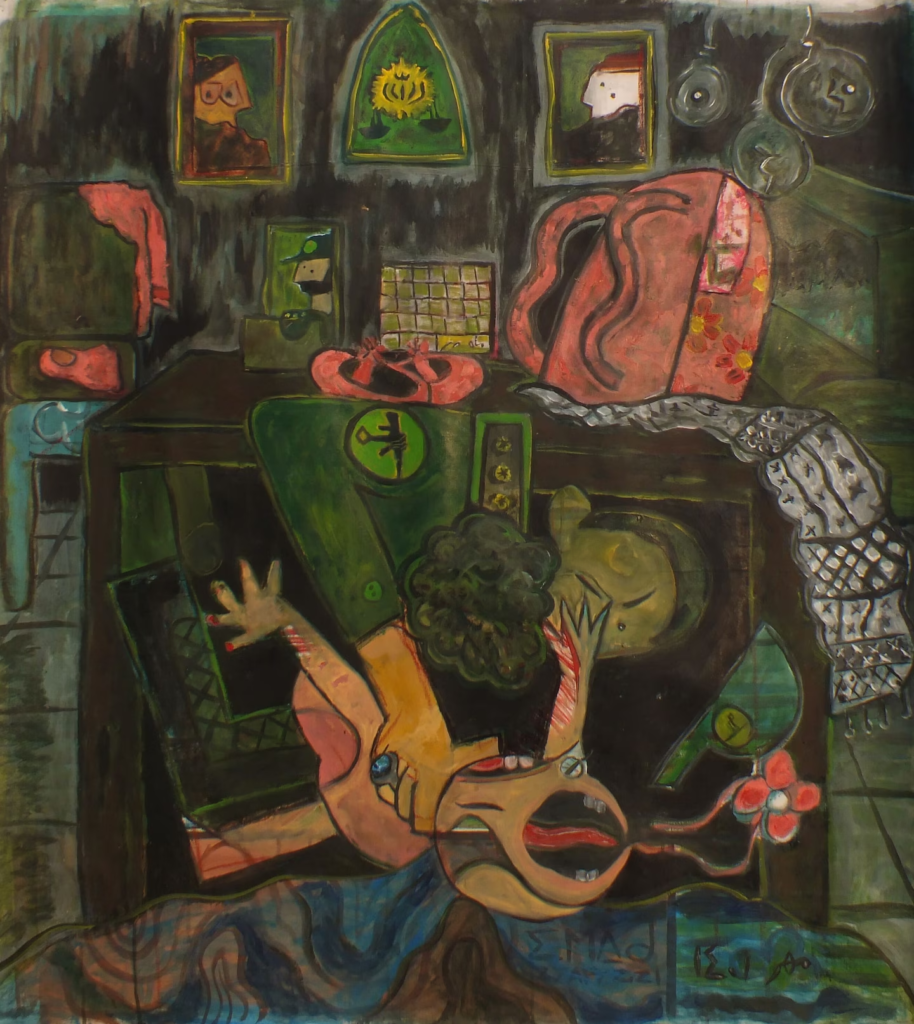
The Washington Post, April 8, 2023 at 4:00 a.m. EDT

A painting by Emad, an Iranian artist in Tehran, representing violence perpetrated by the Islamic Revolutionary Guard Corps. (Emad)
It was incredibly risky to film or photograph the anti-government protests that swept Iran after the September death of Mahsa Amini. In the privacy of their homes and studios, however, some Iranian artists began to take inspiration from the scenes on the streets. Their work reflects the hope, turmoil and tragedy of the popular uprising and the violent crackdown that followed.
After months of rising repression, the demonstrations have died down in recent weeks. But the protest movement, and its slogan of “Women, life, freedom,” has changed the country after more than four decades of authoritarian clerical rule, prompting young Iranians to dream of a different future for their country — and to render it on canvas.
Over the fall and winter, The Washington Post connected with three artists in Iran. They shared their work and talked about how the uprising had influenced their craft. All spoke on the condition that they be identified only by their first names, for fear of government reprisals.

A painting by Emad representing Iranian government repression and propaganda aired by state media. (Emad)
When Emad paints these days, he does so “for all the amazing people they have taken away from us.”
The visual artist in Tehran is “an objector to the Islamic Republic,” he told The Post. So, inside his studio, Emad has turned his oil canvases into a chronicle of the uprising, in which some 500 people were killed by security forces and more than 20,000 were detained, according to rights groups. He sketched how it looked. How it felt. What he hoped for. And what he feared.
He painted a birthday cake “for the victims” to represent “birthdays that were celebrated at graves this year.”

A painting by Emad honoring those killed during the protests. (Emad)
He gravitated toward female figures and visualizing censorship, he said, because “the front rows of this uprising are women” after being “ignored” for so longunder the Islamic republic.
The Islamic Revolutionary Guard Corps, the country’s most feared security force, also featured prominently in his art because of “their inhumane invasions on our minds and bodies,” he said.
Negin, an artist in Kermanshah, in Iran’s northwestern Kurdish region, found herself drawn to self-portraits “for my people all over Kurdistan,” the birthplace of the protest movement.

A self-portrait by Negin, an Iranian artist from Kermanshah. (Negin)
Negin is Kurdish, like Amini, the 22-year-old woman who died in the custody of Iran’s “morality police.” Amini, also known by her Kurdish name, Jina, had been detained for an alleged violation of the country’s strict dress code for women.
“Iran is a land where it’s people have been deprived of simple human rights for many years,” Negin said. “The sorrow born by the murder and massacre of my people, and especially children, is inexplicable with words. I cannot describe it. I only feel it and suffer from it and try to express it in my artwork.”
Art is a “shared language,” she said. “It can blow through our bodies like a breeze and carry this message of pain.”


Left: A self-portrait by Negin (Negin). Right: A self-portrait of Negin holding a bleeding heart (Negin).
In one of her paintings, Negin said, she took “a very close look into myself, my fears, my bravery, restrictions and freedom, thoughts and feelings. … With the fight for freedom going on in the outside world, the struggle for inner freedom also manifests itself.”
Farnoud, an artist in the northern city of Rasht, painted to remind himself of what he called the uprising’s inner light.
“In the dark,” he said, “thoughts of what is going on in the outside world don’t leave you alone,” a feeling he depicted with blood and fire.

A painting by Farnoud, an Iranian artist in Rasht, showing the government’s “defacement of women.” (Farnoud)
“Wherever we look, there are bodies that do not have life anymore, and we feel death is swallowing us all,” Farnoud said.
“But finally in the darkest moment, life will show itself,” he said.
He said he uses his work to remind himself of a core truth: “Deep inside your consciousness, you know the light is sitting somewhere beyond all the ugliness.”


Left: A painting by Farnoud conveying the darkness felt after the government’s repression of the uprising. (Farnoud). Right: A Farnoud work depicting “blood and fire” and the light “sitting somewhere beyond all this ugliness.” (Farnoud)
The streets of Iran are calmer now, at least on the surface. The government appears to believe the worst of the unrest is over, issuing pardons to thousands of people arrested during the protests.
But some Iranians say the movement has only completed its first phase and is waiting for another spark. The country’s artists will be there to document what comes next.
“We have lost so many valuable friends. So much blood has been shed,” Emad said, “The world needs to see that and be moved by it for action.”
